Features of plastic borders

To create an even framing of paths, lawns, flower beds in the garden and in the backyard, special devices are often used - curbs. Successfully chosen, they will favorably emphasize the advantages and hide the disadvantages of landscape design. What material and style to choose is an individual decision. The article will focus on a modern and convenient plastic fence.
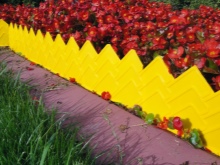
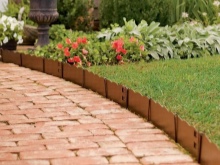

Advantages and disadvantages
Choosing a new design for a personal plot, the owner wants to know what characteristics and features plastic products have, what is the convenience of their use, and where they will have to face unpleasant surprises.
What are the advantages:
- a light weight;
- spectacular appearance;
- quickly install and remove;
- resistance to temperature and humidity changes;
- serve for a long time;
- just look after;
- acceptable price;
- a huge selection of models in color, shape and functionality.
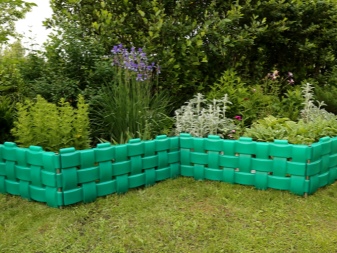
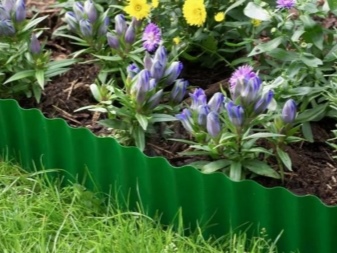
For fans of landscape design, this type is ideal - often you have to change something on the territory: move the garden beds, move the paths.
Concrete elements, laid "for centuries", will interfere with such changes, and lightweight plastic can be moved in a short time.
You can lay a plastic structure in different ways: like a regular curb or curb - then it will protrude over the path and lawn. There are options for creating invisible borders.

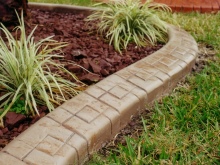
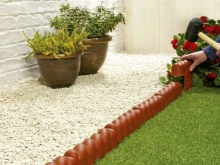
What are the disadvantages:
- The material does not decompose in the natural environment - this makes it harmful to the environment. Plastic products will not harm garden plants, pets and people, but require special processing after the end of use.
- Deforms under strong pressure and may break, ignite from fire.
- Not suitable for public places, as it is easy to remove, bend, ruin.
- Not suitable for framing a car park or garage.
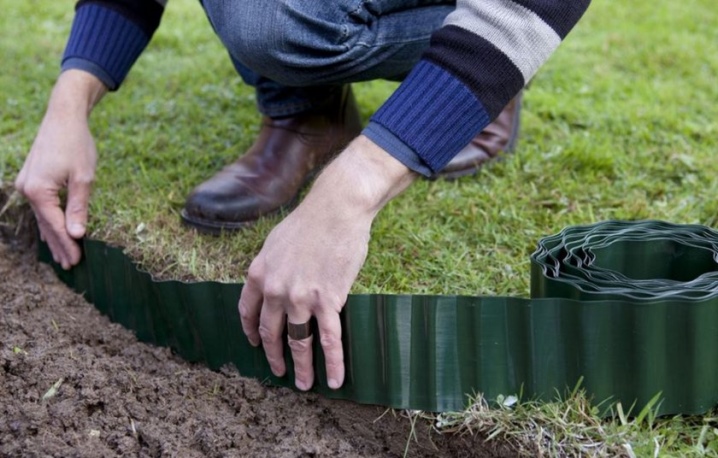
Varieties
According to the methods of installation and use, design features, several types of plastic borders are distinguished.
Sectional
Consists of small modules, different sizes and configurations. The module is fixed in the soil with special pins. Sectional (modular) structures can delimit the flower bed from the lawn area. They are easy to assemble and disassemble. For installation, it is enough to dig into the soil. This view will perfectly protect from passers-by, children and pets.

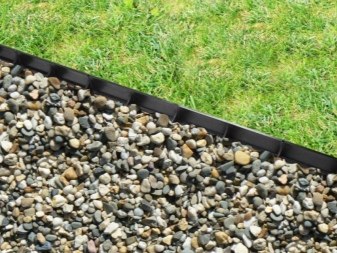
Tape
It looks like a roll of plastic tape with a width of 5 to 15 cm. It can repeat the most intricate twists of paths. It digs into the ground and separates the different zones on the site from each other. They are ideal garden restraints for forming beds.
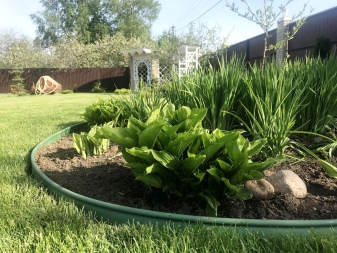
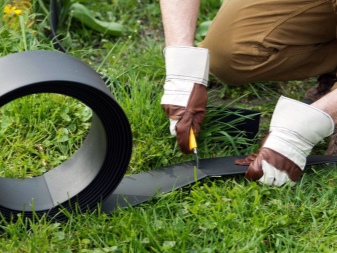
Rolled tape curbs can be dug in to any depth, so the roots from the separated area will not get out.
This flat and flexible divider helps to create space for different plants so that the root system does not end up in adjacent beds. Perfect for flower beds at different heights. For trees, such a detail will help in creating the boundaries of the trunk circle. Here you can distinguish: for the decoration of flower beds and sidewalk. The curb tape serves to separate the lawn from the sidewalk, allowing you to give the landscape any configuration.

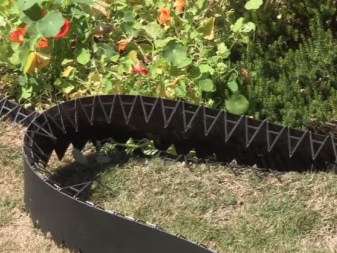
Ready
The aesthetically designed structures give the impression of stone, plaster or concrete elements.They consist of separate fragments, create opportunities for design experiments on the site. The decorative element is great for framing paths and front gardens. Landscaping on a personal plot using such elements will acquire uniqueness and picturesqueness.
A lawn curb under a stone or wood will bring originality to the design of the site.
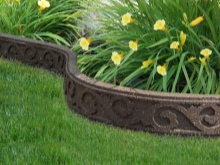

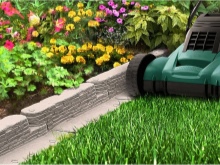
Height and length
For the first time, limiting plastic elements began to be used about 5 years ago. Today this type of fencing is used quite often. Models made of synthetic materials are of high quality and durable. They are produced in accordance with GOST standards and can have both standard and branded sizes.
Standard parameters of a conventional garden curb:
- in length from 500 mm to 1000 mm;
- in width 45, 50, 80 mm;
- in height 200, 210 mm.
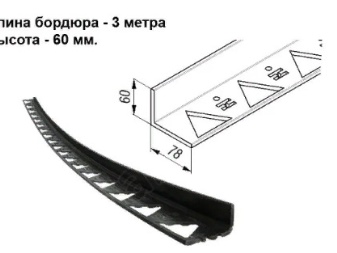
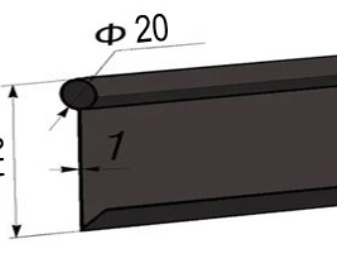
Plastic models have a wide range of sizes. The sectional corner can be sold in lengths from 1.5 meters to 3 m. The height varies from 45 to 80 mm, the width of the base is about 80 mm. It perfectly separates surfaces inside the lawn: it is suitable for decorating bushes, trees, flower beds, as well as for edging paving slabs.

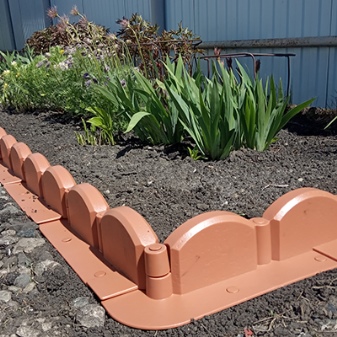
Ready-made plastic decorative structures with or without a curb in width can vary from 38, 60, 80 mm, and a height from 4-5 to 20 cm. In length, such sections correspond to the standard, but there are also longer models.
Used to give the garden a certain style, cost-effective compared to natural materials.
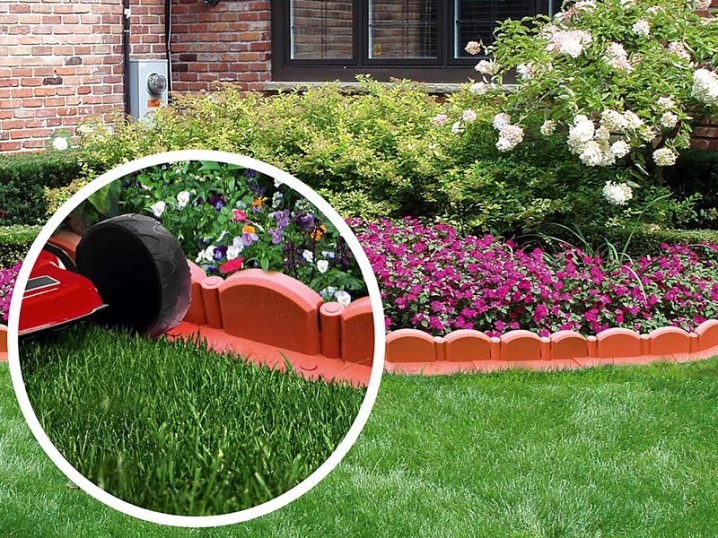
The plastic curb tape can be 10 to 30 cm wide and 10 to 50 meters long. Deeply dug wide belts will protect adjacent paths and beds from the roots of fast-growing plants, will not allow moisture and weeds to pass through. The tape is indispensable when creating multi-level compositions, when using decorative chips and crushed stone.

Colors
Synthetic material is painted in any color scheme that does not fade under the influence of sunlight in summer. This is very convenient when you consider that even natural materials are affected by ultraviolet radiation.
- Terracotta color (imitation clay) - juicy and bright colors will create a pleasing to the eye edging around the front garden.
- Sand - a neutral light color fits perfectly into any background, it can also be used for contrast, for example, on green grass.
- Blue - an elegant color that attracts attention. Blue goes well with deep green, ideal for flower beds with white and yellow flowers.
- Brown - it can be of a variety of shades, from light beige to dark brown, often a light scale is selected for a flower garden or garden, and a dark one for decorating tiles on a path. But there may be a reverse color layout as well.
- Green - a variety of shades, from light green to protective, lighter options will favorably emphasize the border, and dark ones will unobtrusively smooth the transition between zones.
- White - will look universally framed by a flower bed, path, lawn.
- Gray - will create a soft transition between different zones on the personal plot. Sometimes they are used only for edging lawns and paths.
- Black - the most popular color, helps by creating clear boundaries, does not accentuate attention and will look like part of a plant composition.
- Combining several colors in the garden, you can achieve interesting design solutions.
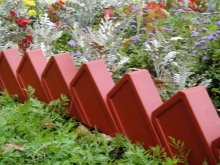
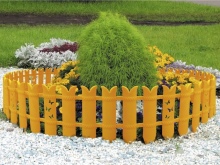
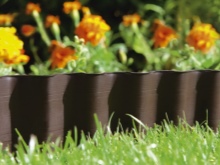
Popular models
Country
It is a dense tape with a rounded hollow edge on the upper part, at the bottom it has a bend for easy fixing in the ground. When installed in a depression in the soil, only the upper edging is left on the surface. This elastic and flexible plastic curb is resistant to temperature extremes, resistant to humid and dry climates, with a service life of about 10 years. They are used to design winding paths, geometric flower beds, site zoning and reinforcement of coatings - tiles, concrete, granite.
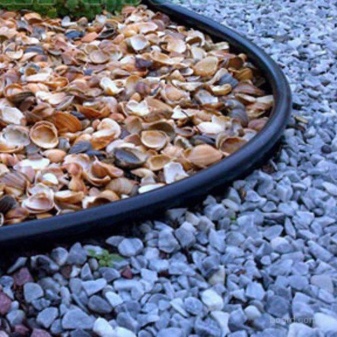
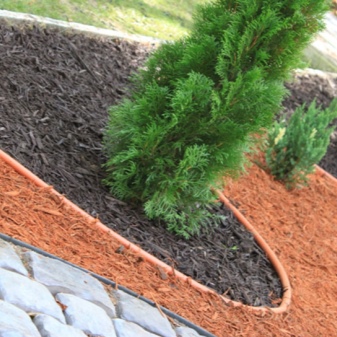
Maze
Made in the form of separate blocks that resemble flat stones. After installation gives the impression of ancient masonry. Supplied unassembled. When assembling, each block is connected to the neighboring one according to the principle of puzzles. The decorative structure is placed on the surface of the soil, in which it is fastened with long narrow pins. An excellent option for a front garden, which is located on the border with the lawn.
The model has a platform where the lawn mower can conveniently pass.
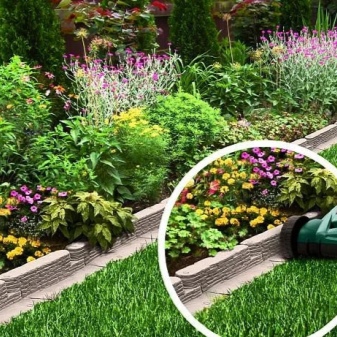
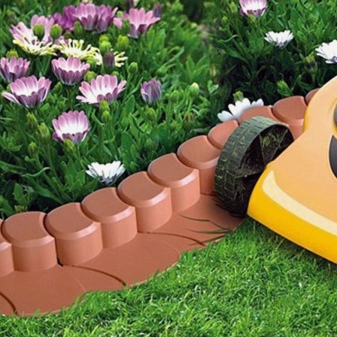
Old stone
The name was given for the similarity in appearance to ancient bricks. It is assembled from individual elements that can vary in both length and height. This allows you to create an individual type of masonry. The parts are connected between the failure using grooves and are fixed in the ground with special devices - plastic pins. It is not suitable for framing winding areas; it is recommended to lay in straight segments or at a slight angle. After installation, lightly sprinkle with sand from below.

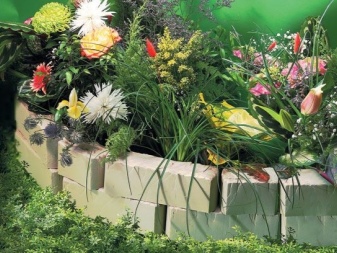
Wave
Parts of the decorative structure can be easily docked with each other and fixed in the soil with special nails. Each detail has a rounded shape on top; after installation, the border becomes wavy. Standard height 9 cm. Suitable for delimiting a flower bed from a lawn or sidewalk, has a small flat ledge for easy cutting of grass with a lawn mower.
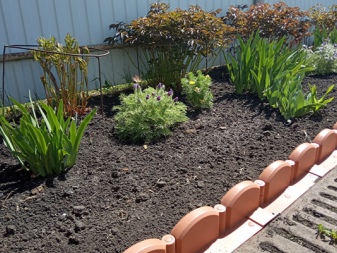
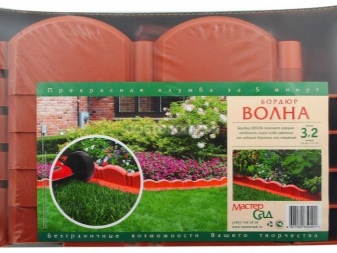
Curb tape
An economical and easy tool to demarcate your front garden, vegetable garden, garden paths and lawn. Sold in rolls from 10 to 90 cm high. Slices of the required length are dug in to the desired depth, which creates a barrier to plants, soil, gravel and other materials. The figured version will make the fence not only neat, but also aesthetic. Palisad corrugated tape looks like a small fence and makes the frame voluminous. The disadvantage is instability with a shallow or ill-conceived installation.

Decorative brick
For owners who traditionally prefer to decorate their front gardens with bricks, this option will be interesting. Externally imitates ceramic bricks, laid on top of each other at an angle of 45 degrees and dug one third into the ground. Ease of installation, durability and ease of use can be called a clear advantage.
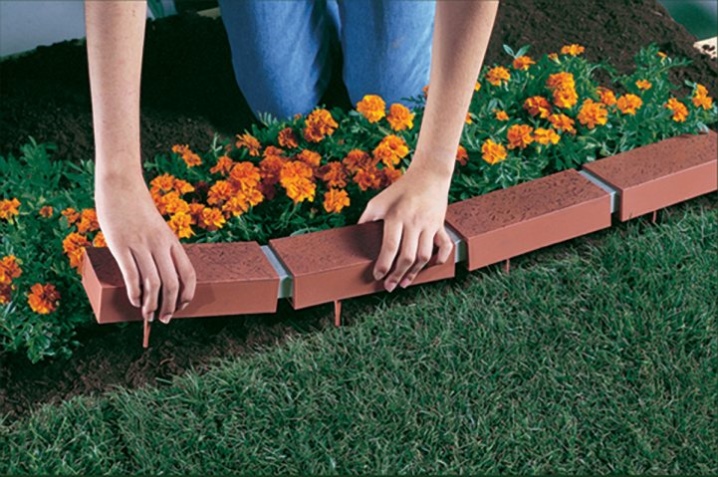
Not intended for curving or steep bends.
Hemp
The modules outwardly resemble wood hemp dug into the ground, about 15 cm high, 10 cm in diameter. At the same time, it can be used as a low fence, it is easily fixed in the ground and accepts any bend. Suitable for decorating a front garden, children's sandbox, tree or shrub.
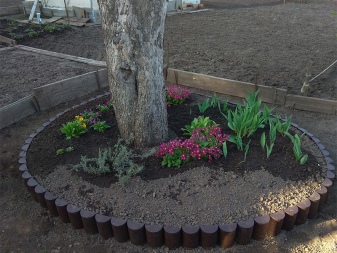
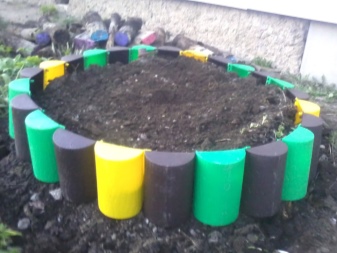
Garden board
Durable and lightweight, it will appeal to fans of natural wood. The parts are connected to each other with special fasteners, easy to install and assemble.
Suitable for fencing greenhouses, greenhouses and creating a unique landscape in the garden.

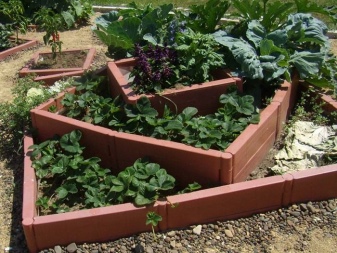
Geoplastboard
The most popular type to use. Versatility of use, ease of installation, durability - these are the main advantages of these designs. Geoplastboard is an invisible border. It delimits areas, firmly fixes the edges of the lawn and tiles on the sidewalk, separating the zones in the flowerbed, remains invisible. The sections are firmly connected to each other and securely fastened in the ground with special devices. Sold in rolls, installed in excavated recesses.

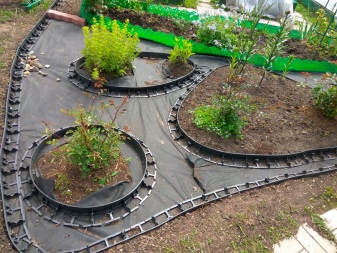
Curb corner B-300.8, 5.4.5
This design is an alternative to the previous type. It has an angular shape, and in the lower part there are triangular holes. Fastened into grooves in the ground with a longer lower part using special pins. A layer of earth can be poured over the corner part or cemented. Suitable for lawns, paths, front gardens, creates dedicated areas on the site. Design in different configurations and bends is possible.
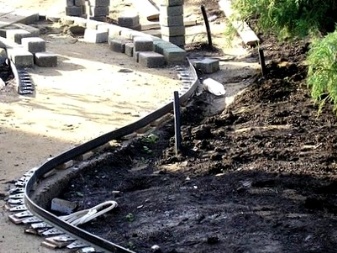
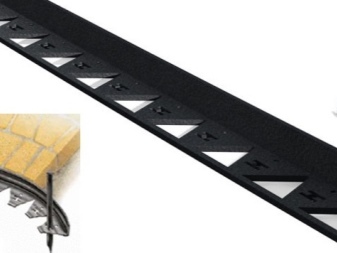
PVC panels
Often, gardeners use this popular finishing material to decorate beds and flower beds. Such panels are quite dense and stable, easy to install and easy to assemble. Withstand temperature extremes. They can be used to assemble both small flowerpots and a long fence for a flower bed. Among the disadvantages are fragility and the inability to make a curved structure.
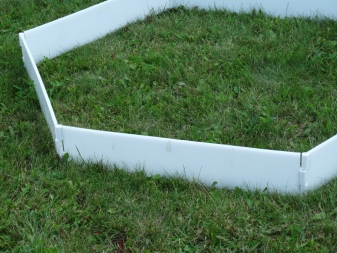
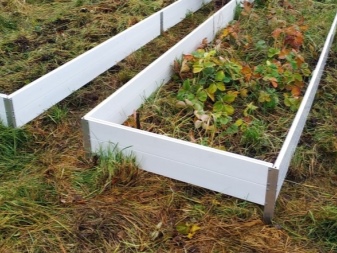
Selection Tips
Choosing a plastic border for a summer residence, you can clearly distinguish the beds, flower beds, areas around trees and bushes. Plants will cease to grow beyond the allotted boundaries, to get out on the paths. The use of a border tape will protect neighboring beds from waterlogging - this is important if moisture-loving plants that love infrequent watering grow nearby. Water from the beds will not fall on the gardener's feet and will not allow the flower garden to float from the rain.
It is practical to combine a ribbon in the garden with a decorative frame.

Decorative structures aesthetically and effectively frame the backyard area, limit the upper part of the green spaces. Unlike curb tape, they do not create insulation underground. If the area in the garden has not yet been marked out for beds and paths, you can use country models, a geoplastic board and a corner border (B? 300.8, 5.4.5). They will help to divide the garden into clear zones, separate lawns, flower beds, and edging paths. These plastic structures are pre-dug into small trenches, and then soil, tiles, gravel and other materials are laid on top.

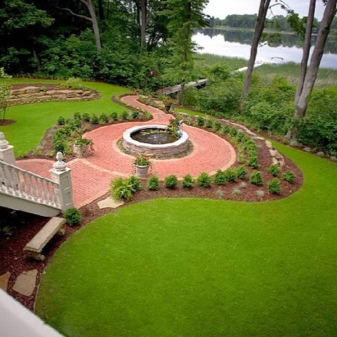
Installation secrets
Of course, each type of plastic construction requires an individual approach. Models made of synthetic materials have one thing in common - ease of installation.
Laying curly borders is as follows.
- To design beautifully curved zones, they choose: border tape, country, geoplastic board, border corner (B? 300.8, 5.4.5) - this is considered a tape variety.
- The tape type must be rolled out of a roll and laid out in the sun - warmed up, it becomes more elastic, it is easier to bend and cut it.
- For greater stability in the place of inflection, the tape is additionally fixed.
- Grooves are made of sufficient depth (about 9 cm) and width so that it is convenient to place the elements.
- The strip is immersed in the recess, and if there are additional fasteners, they are driven into the soil.
- Press and sprinkle with soil to ground level.
- There are no additional fasteners for the curb tape, and the country designs, geoplastic board, corner curb, before digging in, are fixed with plastic pins.
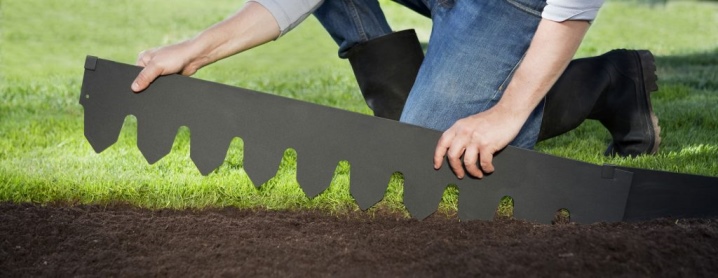
Application features
- the border tape is well suited for beds and flower beds;
- for paths made of tiles, paving stones, a corner curb is suitable (B? 300.8, 5.4.5);
- paths made of bulk material (gravel, sand) are best separated by a country curb.
It is very easy to install decorative plastic models.
- The modules are unpacked and assembled (if necessary).
- They are installed in a chosen place; for this, each structure has special pegs.
Installing the plastic curb in the video below.































































The comment was sent successfully.